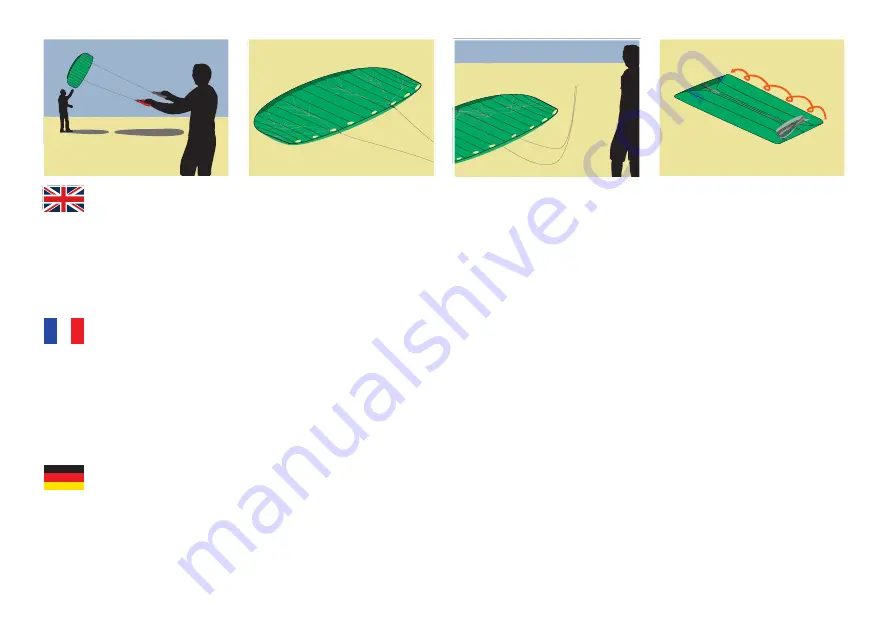
L A N D I N G & P A C K I N G U P
A T T E R I S S A G E E T R A N G E M E N T
L A N D E N U N D E I N P A C K E N
First check if the area is clear of people. Fly
the kite to the ground at the edge of the wind
window. Here a helper may grab and secure it.
Vérifiez d’abord que la zone d’atterrissage est
libre. Placez l’aile en bord de fenêtre du vent.
Un assistant peut l’attraper.
Lorsque vous utilisez votre aile avec une barre,
si vous lâchez la barre, l’aile va perdre toute
puissance et se poser lentement au sol.
Kontrollieren Sie zuerst ob im Landebereich
keine Passanten sind. Fliegen Sie den Kite am
Windfensterrand Richtung Boden. Ein Helfer
kann den Kite fassen und sichern.
Vous pouvez laisser les lignes connectées à l’aile
ou défaire les noeuds “tête d’alouette” pour at-
tacher les lignes au bridage. Accrochez le bridage
dans le velcro situé au bord d’attaque. Enroulez
les lignes en “huit” autour des plaquettes ou
directement sur la barre pour éviter les noeuds.
Die Flugleinen können am Kite angeknüpft
bleiben, oder entfernt werden. Sichern Sie die
Bridle Loops mit den Klettverschlüssen an
der Anströmkannte. Wickeln Sie die Leinen
in Achter-Form (überkreuzt) auf die ‘Winder‘
oder Bar, damit die Leinen sich nicht verhed-
dern.
Sécurisez l’aile avec du sable ou tout autre
lest. Une aile peut facilement s’envoler toute
seule si elle n’est pas lestée convenablement
et que les lignes sont en tension, surtout dans
le vent fort.
Sichern Sie den Kite mit Sand oder anderen
Gegenständen. Vor allem bei starkem Wind ist
es wichtig den Kite hinreichend zu sichern um
ein erneutes Auffliegen zu verhindern. Es darf
kein Zug auf den Leinen sein.
Retirez ensuite le sable ou la terre de votre aile
et pliez-la, en commençant par rabattre les
oreilles vers le centre jusqu’à ce qu’elle rentre
dans le sac.
Rangez votre aile, avec vos poignées ou votre
barre, dans le sac pour éviter qu’elle ne s’abîme.
Entfernen Sie Sand oder anderen Dreck aus
Ihrem Kite. Falten Sie den Kite zusammen,
von den Enden aus nach Innen ; und rollen Sie
dann den Kite zusammen, bis er in die Tasche
passt. Stecken Sie den Kite, mit Flugschlaufen
oder Bar, in die Tasche um ihn vor Beschädi-
gungen zu schützen.
Secure the kite with some sand or other suit-
able weight. Especially in strong winds, a kite
can easily take off again, so make sure there is
sufficient weight on the kite and there is no
tension on the flying lines.
You can leave the flying lines attached to the
kite, or loosen the larkshead knots attaching the
flying lines to the bridle. Secure the bridle loops
with the Velcro tag on the leading edge. Wind
the flying lines in figure eights onto the winder
or the control bar, to prevent tangles or twists.
Then remove any sand and dirt from the kite
and fold the kite, starting from the tips towards
the center, until it is small enough to fit in the
bag.
Put your kite, with straps or control bar, in the
bag to prevent it from getting damaged.
Summary of Contents for 2-Line Kite
Page 1: ...F O R 2 L I N E K I T E S...










































